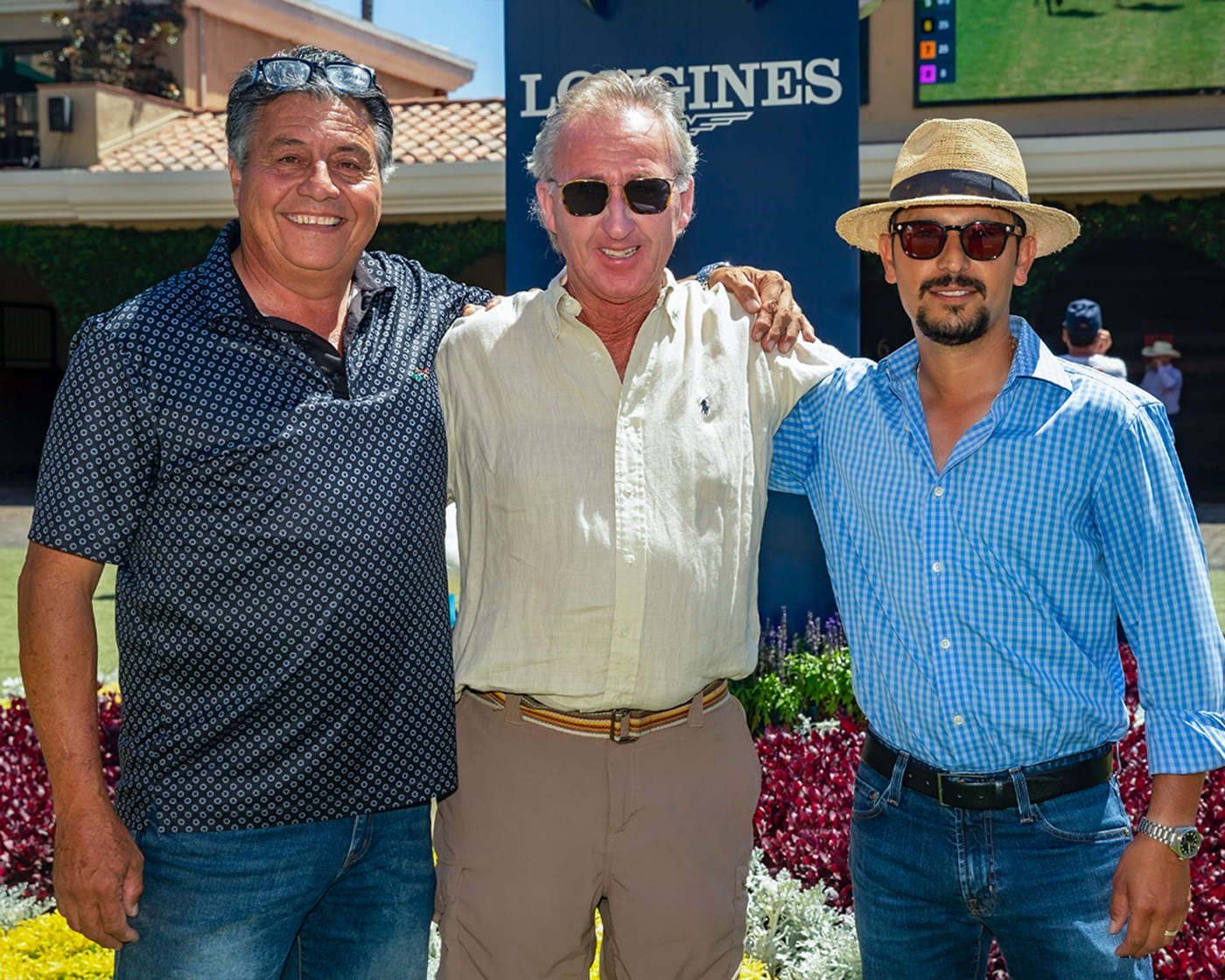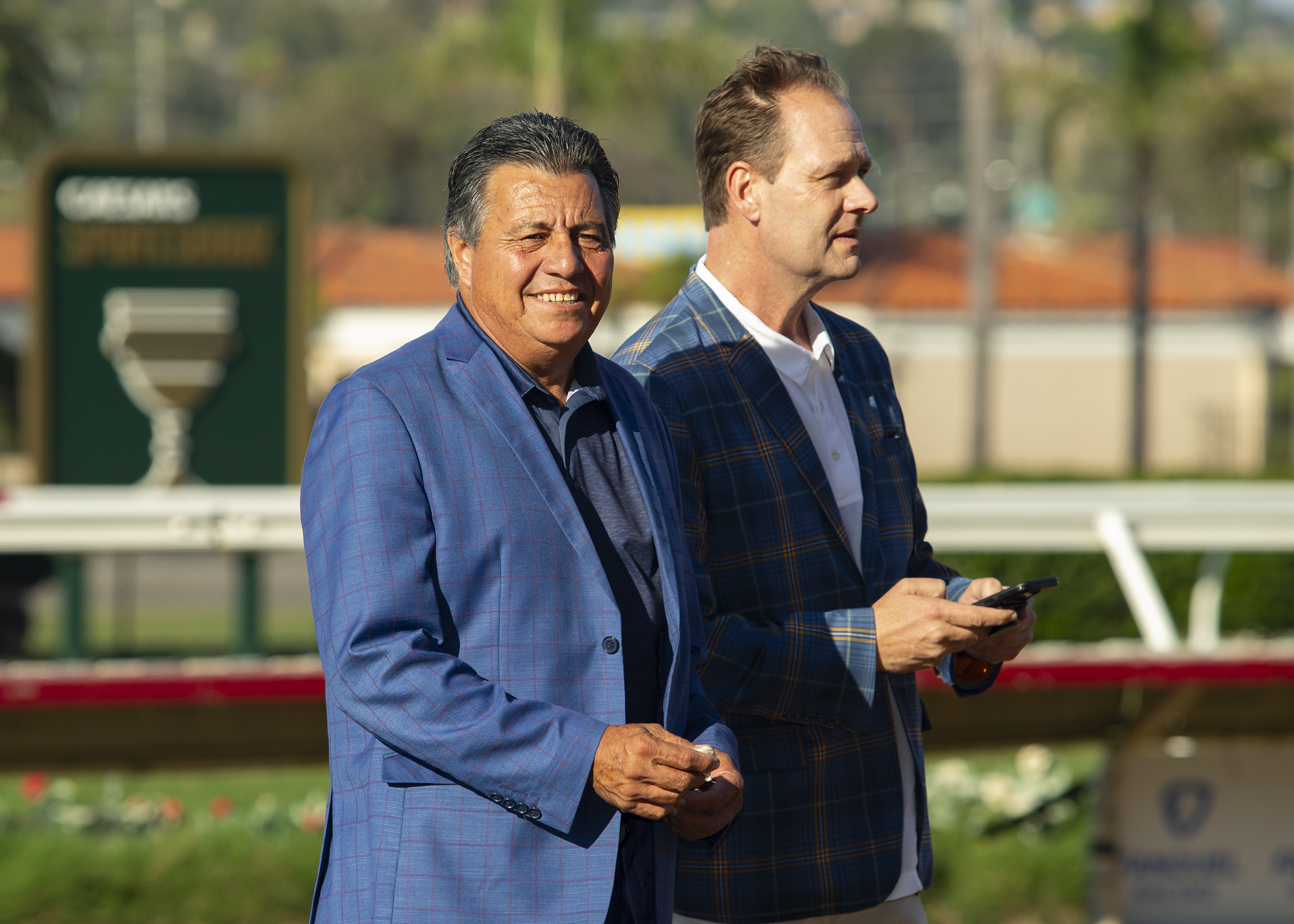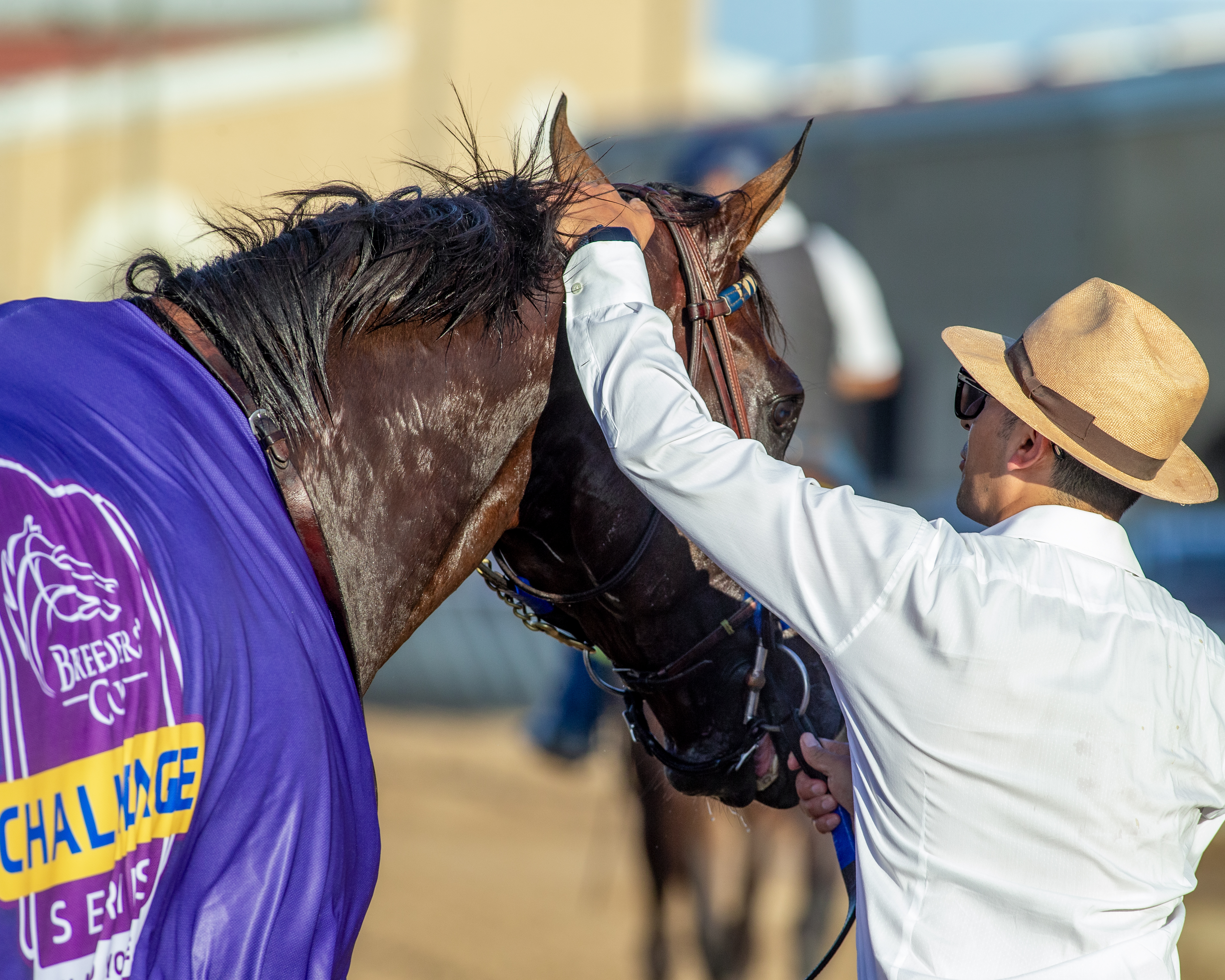
(L to R) Leandro Mora, John O'Donoghue, Juan Leyva © Benoit Photo
There are not a lot of guarantees in horse racing, but you can bet your bottom dollar that behind every successful trainer, there’s an excellent assistant. The trainer is the face of the barn. He or she comes up with the game plan for each of the horses in the stable and it’s up to the assistant trainer to make sure that plan gets carried out to the letter.
The assistant trainer manages the staff and is the line of communication between the grooms and the trainer. Go by any of the big barns on the backside at Del Mar and you’ll find the trainer working in tandem with his assistant.
Three of the most respected, experienced and talented assistant trainers at Del Mar are Leandro Mora with the Doug O’Neill barn, John O’Donoghue, Hall of Fame conditioner Neil Drysdale’s righthand man, and Juan Leyva with John Sadler.
Here are their stories.

Leandro Mora & Doug O'Neill © Benoit Photo
Leandro Mora started working with O’Neill in 2001 after bouncing around at several barns over the years, learning the tricks of the trade. He was born in the state of Jalisco, Mexico in 1959 and raised in the state of Colima, a tourist area near Puerto Vallarta.
“I was raised by the beach until I was 16,” Mora remembers. “A friend of my dad’s was a chef in Modesto, California. So we made the trip to Modesto in 1977 and the guy who brought us decided he wanted to stop at Del Mar on the way, to visit a couple of friends who were working at the racetrack. Once I stepped into Del Mar and saw these beautiful, majestic looking horses, I told my friend to go on to Modesto. I was staying here.”
Mora had a little bit of experience working with animals. His father was a farmer and he had a couple of horses.
“They were plodders,” Mora says. “I would ride his horses and chase the cows.”
He hooked up with trainer Gary Jones as a hot walker for about seven months, then jumped over to groom horses at David Bernstein’s barn where he worked for about eight years.
“Bernstein went big and he needed a foreman,” Mora recalls. “I spoke some English and he had quite a few workers who spoke no English so I was a translator and foreman at the same time. I got my trainer’s license eight years after I had been working for him.“
Mora eventually left Bernstein on good terms and went to John Sadler’s barn. But that only last three months.
“It did not work out well,” he says. “I was trainer of the second string. He’s a good man but I didn’t feel like I fit in, so we split.”
That’s when Mora was introduced to Brian Mayberry in 1986.
“That’s when I became a citizen,” Mora notes. “That’s where I got all the stuff I know now. He was my papa in the United States, he and his wife Jeannie. I stayed with them for almost 14 years.”
It was during the time with Mayberry that Mora got his first taste of the big time when he was part of the team that conditioned Sardula, the 1994 Kentucky Oaks winner. It all came to an end when Mayberry died in 1998 after a long battle with cancer.
“When he passed away I had no choice and had to look for another job,” Mora says. “A veterinarian, Melinda Blue, a good friend of mine said ‘Doug O’Neill needs an assistant.’ He was at Hollywood Park then and I went to talk to him. We’ve been together ever since.
“He’s a terrific guy to work with,” Mora continues. “He treats you like family. He doesn’t treat you as an employee but rather as a brother and that’s why I’ve turned down a lot of offers to train horses on my own.”
Once Mora and O’Neill got together, good times soon followed. They started winning races. Graded races, grade one’s and grade two’s, two Kentucky Derbies and one Preakness.
“Winning the Kentucky Derby gives you chills,” Mora contends, “because winning the Derby is the best thing to ever happen to a horseman. There is no comparison to anything else. When you have a Kentucky Derby contender and you do the walkover, it chills your skin all the way to the saddling paddock. The ‘My Old Kentucky’ song makes it even better.”
Mora gets to the barn every morning by 4:30 and oversees all of the horses, all of the help, even the veterinarians.
“Doug fills out all of the training applications and he hands it to me with what he wants the jock to get done,” Mora explains. “If some horse doesn’t do what he wants to get done then I go to Doug and remind him about that horse and then we go back to where we started and do it all over again. When Doug is not around, when he has to travel for some reason, then I become the trainer’s eyes.”
You don’t just become an assistant trainer because you want to be. There is test all assistant trainers are required to take. It consists of a series of questions and a hands-on portion.
“No way to become an assistant without the trainer’s test,” Mora says. “It is not easy. I failed the first test and passed the second time in 1984. I faced a judge, a veterinarian and another trainer.”
John O’Donoghue has been with Neil Drysdale for over 30 years. He came to the United States in the summer of 1985 to work with John Gosden and stayed with him for four years. Then in ’89, Gosden went back to England and that’s when O’Donoghue moved over to Drysdale’s barn.
“He had a similar type of stable to Gosden’s,” O’Donoghue says.
Raised in Ireland, O’Donoghue was born in the town of Limerick in 1963.
“I grew up with horses,” O’Donoghue remembers, “My uncle was a steeplechase trainer in Ireland and I was riding at a pretty young age.”
He worked with his uncle and rode for him a little bit as an amateur jockey in Ireland. Training was the next step.
“My first real job was working with Vincent O’Brien in 1980,” O’Donoghue recalls. “He was a huge trainer at the time. I was always interested in the training aspect. I love working with the horses, working one-on-one. That’s the biggest thrill. And watching them win is always a huge thrill, too.”
O’Donoghue got an opportunity to come to California for the summer and, like any other 20-something, he didn’t need to be asked twice.
“A guy I was working with in Ireland had connections with Robert Sangster who had horses all over the world,” O’Donoghue says. “He organized a job for me before I came over. It looked like a good experience so I jumped at it and I fell in love with California.”
Almost 40 years later he’s managing 10 grooms and five exercise riders. Drysdale has a string of about 30 horses at Del Mar.
“We start around 6 a.m.,” O’Donoghue says. “We check the horses and get the first set going. We send them out to the track in groups so we get the first group going and we watch them train and clock the workouts. We train six or seven groups of horses. At 10 o’clock we do some veterinary work. And in the afternoon, we go to the races with our runners.”
The job sometimes calls for a quick trip across the country, which is where we found O’Donoghue, in Virginia saddling Nadette in the Beverly D at Colonial Downs.
“We stay at home (in California) quite a bit,” O’Donoghue contends, “but during the summer we usually have some horses back east in New York or, like now, at Colonial. It’s not unusual in the summer for us to travel around.”
Over the years Drysdale and O’Donoghue have trained some very talented horses. 1992 Breeders’ Cup Classic winner A.P Indy; 2000 Kentucky Derby winner Fusaichi Pegasus; 1993 Breeders’ Cup Distaff winner Hollywood Wildcat, and 2002 Eddie Read Handicap winner Sarafan, who retired with over $2.2 million in earnings.
“It’s hard to pick a favorite,” O’Donoghue admits. “You of course like the good ones but you like some of the bad ones just as much, too.”

Juan Leyva & Flightline © Benoit Photo
Juan Leyva joined the John Sadler barn in 2017.
“When I was riding I rode a bit for him (Sadler),” Leyva says. “I was going to move my tack in 2005 and he said, ‘Instead of moving your tack why don’t you come work for me?’ I told him I wanted to ride and I left. We’ve always been good friends and we stayed in contact.”
Sadler would inquire again about 10 years later, but got the same answer from Leyva. But when weight became an issue, it was Leyva’s turn to call Sadler.
“I asked him if he still had a spot for me,” Leyva recalls, “and he did. So, I quit riding that day, drove back to California and started working for him.”
Leyva was born in Mexico City in 1984. He moved with his family to California when he was five.
“One of my first memories was being on my dad’s shoulder at the races,” Leyva recalls. “I was about three years old. Horses have always been in my life. I want to say around nine- or 10-years-old my dad started to teach me how to ride. He always had horses and liked to match race them. So I started match racing when I was 12-years-old up in Riverside. There used to be a track out there where you could race every Sunday. These were unsanctioned races obviously. Two-horse races and that’s where I started so my dad is the one who really steered me to the horses.
“Even though he wasn’t a racetracker per say, he has a lot of inner horseman in him,” Leyva continues. “So a lot of things he taught me I could use. He always told me ‘Whatever you put into horses, they’ll give back to you. If you give them love and attention, they’ll give it right back to you. If you treat a horse bad, they’re going to react that way.’”
When Leyva turned 16 he got his exercise rider license and couple of years later he got his apprentice license. In 2005, he left to ride in Florida.
“I didn’t have much success as a bug boy,” Leyva admits. “I started doing better once I lost the bug.”
For 12 years he rode at Gulfstream Park and Calder Race Course and compiled a nice record. Over 8,600 starts, 803 wins and career earnings over $22 million.
“Most of my riding career was based in Florida,” Leyva says. “That’s where I did the best. I was lucky enough to win a Breeders’ Cup in 2011 on Musical Romance in the Filly & Mare Sprint for a really good friend of mine, Bill Kaplan. He passed away last year but was very instrumental in what I’m doing now. He was a big mentor. He was big on developing 2-year-olds and I learned a lot from him.”
But through it all there was always that itch to return home for Leyva.
“For me, California has always been home,” he says. “When I was in Florida, every day I was thinking about coming home. My parents are here, my three brothers are here as well. Family is what brought me back here.”
And John Sadler.
“Throughout my career I was always asking questions to trainers I felt comfortable talking to,” Leyva notes. “They would always give me little tidbits of information about training horses. Then when I came to work for John the level of education was beyond my imagination. The stuff he knows that he’s given to me I don’t think I could have learned anywhere else. For me, working for John has been one of the luckiest breaks in my life.”
Leyva also credits trainer David Fawkes with helping him and feeding him with good advice on training that he still uses to this day. As well as Ralph Nicks, who took the same trajectory to training as Leyva. He was a rider who became an assistant for Bill Mott.
“The one thing he told me,” Leyva remembers of Nicks, “was when you get in that barn you’re just like everybody else. You learn from your grooms. Get in the stalls with the horses and learn from them. I took that to heart when I got here because naturally you’re not going to know about legs as a rider. You may know how to train horses but you don’t know about legs and taking care of them. Being really tight with the grooms helps you out because in the end they teach you a lot.”
Leyva got thrown into the deep end right away. When he arrived from Florida he was with Sadler for three days at Santa Anita before being sent to Los Alamitos to oversee a 20-horse string.
“I was by myself,” Leyva says. “I didn’t have a foreman. I didn’t have anybody to help me. I was on the phone with John every day. Four in the morning I’m talking with him about what to do with the horses.”
Leyva was at Los Al for six months when Sadler brought him back to Santa Anita.
“The first thing I realized was I didn’t know a thing,” Leyva contends. “Once I got side-by-side with John, I really started learning.”
There are 66 horses at the Sadler barn on the backside at Del Mar and 14 grooms.
“I feel like I get along with all of them,” Leyva says. “Naturally there’s going to be a day when we might have a disagreement but I feel like, all-in-all, we’re a family here and we take care of each other.”
Leyva’s day starts at 2:30. He’s in the barn no later than 3:15. He makes the set lists for the day and checks the horses they’re going to work and the ones with issues. They’re usually done training by nine o’clock. Then at 11 they do schoolers in the paddock. After that if there’s no vet work to do he’ll go to his place on the grounds and take a nap. Then it’s back for the races and he finally leaves the barn after they scope the last horse to run that day, making sure they scope clean and if not take steps to treat them.
“It's a long day but when you do what you love it doesn't feel like a long day,” Leyva says. “A big key in being able to enjoy what I do is my wife. She comes from a racing family as well. She was a jockey and exercise rider. Her dad was a trainer, her brother was a trainer and jockey so she knows the life and she expects me to do right by the barn.”
Leyva and his wife Kristi have been married for 12 years though they’ve been together for 20 years. Her name used to be Kristi Chapman. She was a good rider in her own right, tallying 440 wins and career earnings over $7 million. They have two kids, a daughter that’s 11 and his son is nine.
“They’re not really inclined to the horses,” Leyva notes. “They know what’s going on but it’s not really their world. They’re more into soccer.”
“This life isn’t for everybody,” Leyva continues. “It’s a hard life. It’s long hours. It’s very competitive. It beats you down at times. You can sometimes go two weeks without winning a race and you get to thinking ‘What are we doing wrong?’ And then you have those good days when everything goes right for you.”
Flightline provided many of those ‘good’ days for Leyva. The 2023 Pacific Classic winner and eventual Horse of the Year was a part of Leyva’s life for two years.
“He was a very special horse for me,” Leyva replies. “He taught me a lot about training a horse of that caliber. I rode him every day and the lessons that horse taught me are instilled in my brain. And if one day I get one like him, I’ll know exactly what to do.”
